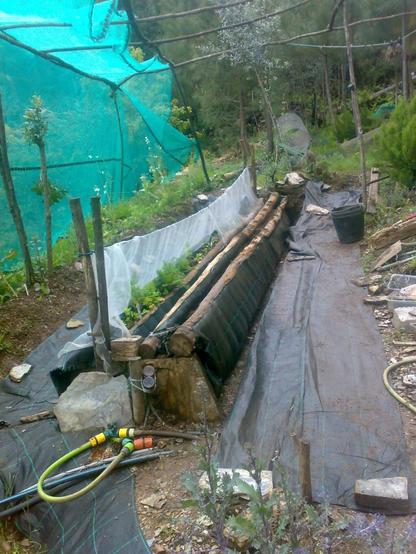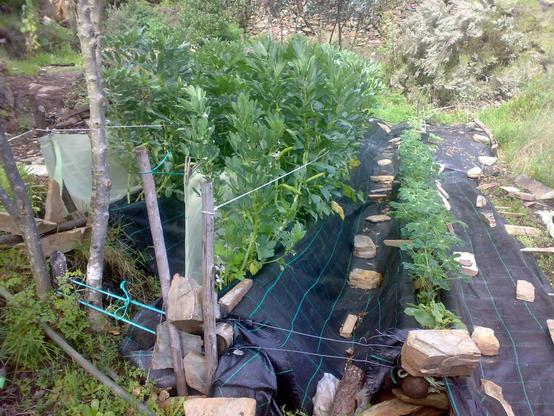11 deg C to 38 deg C [predicted] in a day and a half.
Portugal. 450 m above sea level.
Garden? -- how do you feel about this?
14-15 weeks later -- here's the #strawberry pyramid bed waking-up for spring. It's been under plastic for weeks due to storms and cold, uncovered now for photo and maybe some pollination? Strawb fruit elsewhere in boring containers, but the slugs have beaten me to them so far...
#growYourOwn
...the pair of root-veg beds just rebuilt, before the rebuild, extra post just so you see the thumbnail in column.
To finish, a couple of photos of edible Lupins - thread to come at some point if no-one gets there before me. not doing as well in a wilder bed with who-knows-what going on beneath the ground, as in the "stretcher bed" interplanted with small and salvaged seed potatoes.
Reasons for building these elaborate raised beds ... 1] soil homogeneity and delineation - they are filled with sieved soil from the very patchy pockets of better surrounding soil, including of course the path areas to which the gravel is returned, plus gathered humus and commercial media. 2] root exclusion of the many surrounding shrubs and trees. Bracken itself was frequently pushing through other beds I thought I'd already cleared of it. 3] BURROWING RODENT disturbance. Voles hunting earthworms, disturbing the roots of young plants, were causing stunting of much of a crop. Then mice, eating the actual roots and foliage of almost mature carrots. 4] soil-creep and nutrient run-off prevention, on 10 - 20 degree slopes -- and that's on the terraces /between/ the walls! 5] available, durable, economical, not-too-in-your-face materials. I don't have or want a heavy vehicle on the road for industrial materials used to build typical raised beds, and access is via very remote, steep tracks unsuitable for most vehicles. The woven ground-cover fabric is durable and very economical in use and will of course eventually be recycled. The poles are from boundary eucalyptus plantation encroachment. The fixings are heavy-duty staples and 2.5 mm fence wire.

The favas "Algarve" in the prime STRETCHER BED however are NOT having a problem with light olive-bush and cork-oak shade. But their ROOTS are for now, well isolated and fed. This is the whole point of my stretcher beds concept: a 5-6 m sleeve of woven ground-cover fabric, with a diameter of about 30 cm, suspended on 2 ~10 cm poles. The prototype was indeed suspended above ground, with very light decaying pine-pith and straw/wood equine-bedding commercial compost over it. Only 1 truly suspended bed was built, autumn 2024. I put it in the afternoon shade of a cork, fearful of dessication. E-W wind dessication and stem shaking seems to be as big a problem, 60 cm above what is already a ridge. The soil in the sleeve DOES DRY / cool / heat more than it would if contiguous with the ground, so all the 5 subsequent beds have been sat in contact with the [sub]soil and have the path ground-cover fabric pulled-up to the base of the stems of the crop. This "double-insulation" seems to be well worth it. There are parsnips and beetroot cleverly concealed among the stretcher-bed favas.

Some surprises. First the pioneers -- "Aquadulce improved", Italian seed: /surprise 1/ -- their own nitrogen-fixing root-bacteria -- if actually present -- were NOT enough to nourish them. The parts of the planting I gave no artificial fertiliser are less than a 10th of the size and crop of those with 2 applications of 10:10:10. /surprise 2/ -- bracken allelopathy [ptaquiloside] does not seem to stunt the established plants. I've let bracken grow-up in the rows but am limiting it: the favas seem OK with the extra wind-support, humidity and slight shade; where it starts to dominate, it is removed. However /surprise 3/ -- bracken and fava growth, even with the fertiliser, seems to be inhibited around the broom -- Spartium [junceum?] even where the broom has had 50 - 95% of its above-ground structure removed. This MAY also be a facet of afternoon cork-oak shading [intentional] but presently excessive over this EXTREMELY CLOUDY SPRING here.
Experimenting with Vicia faba -- "favas", " #BroadBeans " in both my own "stretcher bed" concept and as pioneers -- " #fieldBeans " on steep roughly terraced shallow, shaley soil over solid shale. They thrive locally [see profile] in high central Portugal. During the long cold wet part of the Mediterranean climate-flip, anyway. So the best time to plant them would be ... when they would germinate as volunteers when the autumn rains hit them after drying thru the summer on the dead stem. The self-sown ones would be already worth picking, if enough of them. [image]. Ditto the self-sown snap-peas [slugs unexpectedly ate all 30+ intentionally raised seedlings].
2024 crop I started germinating on 26 Jan yielded first big pick on 25 Jun. But the plants were exhausted by the heat not long after the end of June. The current crop I managed to start on 27 Nov and looks like some will have decent size beans by end of April.
#growYourOwn
"This data visualisation, based on C3S data, shows the total precipitation anomaly in Europe for the month. It highlights that most of southwestern Europe was affected by above average levels of precipitation, particularly over the Iberian Peninsula. This region was hit by a series of severe weather events which led to widespread flooding. On the other hand, in the UK, Ireland, and a section of central Europe expanding southward to the Black Sea, Greece, and Türkiye, the month was drier than average."
https://www.copernicus.eu/en/media/image-day-gallery/precipitation-anomaly-europe-march-2025
#europe #climate #Copernicus
Precipitation anomaly in Europe, March 2025 | Copernicus
@urlyman thoughts on the thread? ⬆️ ⬇️